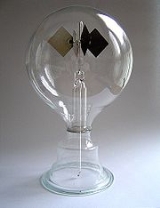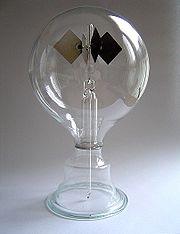
Radiometer
Encyclopedia

Radiometry
In optics, radiometry is a set of techniques for measuring electromagnetic radiation, including visible light. Radiometric techniques characterize the distribution of the radiation's power in space, as opposed to photometric techniques, which characterize the light's interaction with the human eye...
(power) of electromagnetic radiation
Electromagnetic radiation
Electromagnetic radiation is a form of energy that exhibits wave-like behavior as it travels through space...
. Generally, the term radiometer denotes an infrared radiation detector, yet it also includes detectors operating on any electromagnetic
Electromagnetic radiation
Electromagnetic radiation is a form of energy that exhibits wave-like behavior as it travels through space...
wavelength.
A common example is the Crookes radiometer
Crookes radiometer
The Crookes radiometer, also known as the light mill, consists of an airtight glass bulb, containing a partial vacuum. Inside are a set of vanes which are mounted on a spindle. The vanes rotate when exposed to light, with faster rotation for more intense light, providing a quantitative measurement...
, an early-model device wherein a rotor (having vanes which are dark on one side, and light on the other) in a partial vacuum spins when exposed to light. A common myth (one originally held even by Crookes) is that the momentum of the absorbed light on the black faces makes the radiometer operate. If this were true however, the radiometer would spin away from the non-black faces, since the photons bouncing off those faces impart even more momentum than the photons absorbed on the black faces. Follow the link below for an in-depth explanation of the principles behind a Crookes radiometer.
The Nichols radiometer
Nichols radiometer
A Nichols radiometer was the apparatus used by Ernest Fox Nichols and Gordon Ferrie Hull in 1901 for the measurement of radiation pressure. It consisted of a pair of small silvered glass mirrors suspended in the manner of a torsion balance by a fine quartz fibre within an enclosure in which the air...
operates on a different principle and is more sensitive than the Crookes type.
A microwave radiometer
Microwave radiometer
A microwave radiometer is a radiometer that measures energy emitted at sub-millimetre-to-centimetre wavelengths known as microwaves. Their primary application has been onboard spacecraft measuring atmospheric and terrestrial radiation, and they are mostly used for meteorological or oceanographic...
operates in the microwave
Microwave
Microwaves, a subset of radio waves, have wavelengths ranging from as long as one meter to as short as one millimeter, or equivalently, with frequencies between 300 MHz and 300 GHz. This broad definition includes both UHF and EHF , and various sources use different boundaries...
wavelengths. The radiometer contains argon gas to enable it to rotate.
The MEMS
Microelectromechanical systems
Microelectromechanical systems is the technology of very small mechanical devices driven by electricity; it merges at the nano-scale into nanoelectromechanical systems and nanotechnology...
radiometer, invented by Patrick Jankowiak, can operate on the principles of Nichols or Crooke and can operate over a wide spectrum of wavelength and particle energy levels.
See also
- Radiation pressureRadiation pressureRadiation pressure is the pressure exerted upon any surface exposed to electromagnetic radiation. If absorbed, the pressure is the power flux density divided by the speed of light...
- Net radiometerNet radiometerA net radiometer is a type of actinometer used to measure net radiation at the Earth's surface in meteorological applications.The name net radiometer reflects the fact that it is supposed to measure incoming minus upwelling radiation...
- BolometerBolometerA bolometer is a device for measuring the power of incident electromagnetic radiation via the heating of a material with a temperature-dependent electrical resistance. It was invented in 1878 by the American astronomer Samuel Pierpont Langley...
- PyranometerPyranometerA pyranometer is a type of actinometer used to measure broadband solar irradiance on a planar surface and is a sensor that is designed to measure the solar radiation flux density from a field of view of 180 degrees...
- RadiometryRadiometryIn optics, radiometry is a set of techniques for measuring electromagnetic radiation, including visible light. Radiometric techniques characterize the distribution of the radiation's power in space, as opposed to photometric techniques, which characterize the light's interaction with the human eye...
- SpectroradiometerSpectroradiometerSpectroradiometers are designed to measure the spectral power distributions of illuminants. They operate almost like spectrophotometers in the visible region...
- Copernicus
- Solar sailSolar sailSolar sails are a form of spacecraft propulsion using the radiation pressure of light from a star or laser to push enormous ultra-thin mirrors to high speeds....
- Photon rocketPhoton rocketA photon rocket is a hypothetical rocket that uses thrust from emitted photons for its propulsion. The standard textbook case of such a rocket is the ideal case where all of the fuel is converted to photons which are radiated in the same direction...

